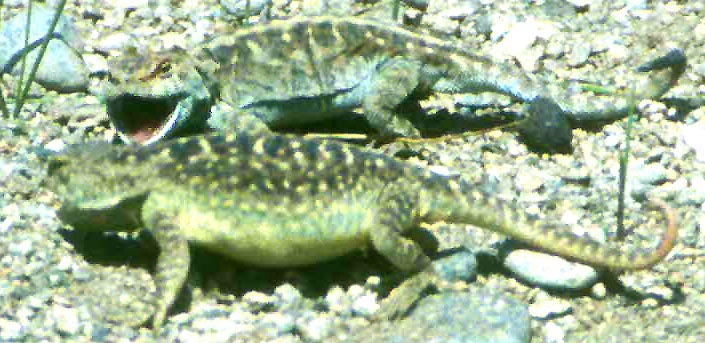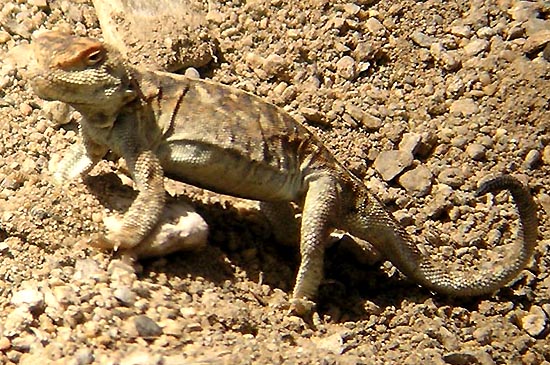
It is now clear that both lizards shown below are Toad-headed Lizards in the genus Phrynocephalus. There are 43 species of Phrynocephalus in the world, and 20 in China, but only two or three species in Qinghai Province. It seems clear to me, for reasons discussed below, that we had two different species. You can find photos of related Phrynocephalus species from Mongolia on Vladimir Dinet's "Deserts" page [his entire web site is a treasure trove of information and fascinating stories].

| Our most memorable lizards were this interacting pair living in a rodent
burrow along the south shore of Qinghai Lake. The two were actively interacting
— sometimes with mouths agage (above) — and seemed likely to be a mated
pair, differing slightly in color and bulk. These high elevation lizards
are viviparous [they bear live young rather than lay eggs].
I have tentatively identified these as Qinghai Toad-headed Lizards Phrynocephalus vlangalii, sometimes called "Vlangal's Toad-headed Lizard." The EMBL data base lists only two Phrynocephalus for Qinghai Province — this means I have a random 50% chance of being correct! Ahem. Actually, the data base indicates that the type specimen of P. vlangalii was taken at Koko-Nor, an old name for Qinghai Lake. Since we saw them there, this intuitively seems correct. Incidentally, the difference in the color of these photos is the difference between film (top photo) and digiscoping (two photos to the right). Odd and interesting.... |

|

|
The second lizard was in the Caka Valley; we found it both in the dry
arroyo and around the abandoned prison (these photos, left, from the latter
spot). It is also a Toad-headed Lizard but differs a bit structurally,
has a black tip to the tail, and has an extensively dark belly patch.
Since the EMBL data base lists only two Phrynocephalus for Qinghai Province — and we've already assigned a name to the other one — by the process of elimination this must be Przewalski's Toad-headed Agama (or Lizard) Phrynocephalus przewalskii. Its range is dry deserts of north China (Nei Mongol, Ningxia, Gansu, and Qinghai). The type specimen was taken in the Ala Shan Desert. Unlike P. vlangalii, it is listed as oviparous (lays eggs). I found some taxonomic abstracts on-line that deal with this species; these are discussed below. Phrynocephalus carinatus and P. elegans may be synonyms; more discussion is below. |
In 2000, Wang, Yuezhao, Fu, and Jinzhong published a paper in Copeia 4:199-206 entitled "Cladogenesis and Vicariance Patterns in the Toad-Headed Lizard Phrynocephalus versicolor Species Complex." I have not yet read this paper, but here is the on-line abstract:
| Using mtDNA sequence data and a phylogenetic approach, the authors examined the divergence and evolutionary history of the Toad-Headed Lizards of the Phrynocephalus versicolor species complex, which are currently assigned to three species, P. versicolor, Phrynocephalus frontalis and Phrynocephalus przewalskii. Both parsimony and likelihood-based analyses resulted in three clades, which do not conform to the current species designation. The three species did not form mutually exclusive monophyletic groups. Instead, the populations from Tengger Desert, Ordos Highland, and further east, which include P. frontalis, P. przewalskii and several populations of P. versicolor formed a clade and we recommend recognizing them as a single species under the name P. przewalskii, The populations from the northwestern part of the complex's distribution also formed a monophyletic group, for which we recommend retaining the name P. versicolor. Finally, the southwestern populations share a unique evolutionary history and should be recognized as a new species, Phrynocephalus sp. The resulting phylogeny suggests that the species diversity and distribution patterns of P. przewalskii, P. versicolor and Phrynocephalus sp. can be better explained by vicariance, rather than the traditional west-to-east dispersal hypothesis. |
Obviously, without reading the paper, I cannot tell what portion of the complex's range may include the Caka Valley. It is possible that this paper confirms that the Caka Valley lizard was P. przewalskii; alternatively, it might be versicolor or something else. This is probably more than you want to know.
In addition, a brand new paper has been published:
Pang, Junfeng; Yuezhao Wang, Yang Zhong, A. Rus Hoelzel, Theodore J. Papenfuss, Xiaomao Zeng, Natalia B. Ananjeva and Ya-ping Zhang. 2003. A phylogeny of Chinese species in the genus Phrynocephalus (Agamidae) inferred from mitochondrial DNA sequences. Molecular Phylogenetics and Evolution 27: 398-409.This paper should also be consulted. I have not yet read it: it may shed a lot of light on our toad-headed situation.
And while on the topic of the Qinghai Plateau fauna, here is another interesting paper: Chien-Hsun Lai and Andrew T. Smith. 1996. Keystone status of Plateau Pikas (Ochotona curzoniae): effect of control on biodiversity of native birds, pp. 222-230 in Conserving China's Biodiversity (II) (Peter, Johan Schei, Wang, Sung and Xie, Yan, eds.). China Environmental Science Press. Beijing. Here is the introductory summary:
| The Tibetan Plateau is largely a treeless environment, and the open meadows that constitute the majority of the plateau ecosystem offer little in the way of protection for nesting animals. The burrows constructed by the Plateau Pika offer breeding habitat for many species. Hume's ground jay (Pseudopodoces humilis) and several species of snowfinch (Montilnngilla spp.) nest mainly in pika burrows (Meyer de Schaunensee 1984, Ma 1995, Schaller 1998, Smith et al. 1990). These birds are more abundant in area of pikas (Ma 1995). Similarly, Pere David's snow finches (Pyrgiauda davidiana) and Isabelline wheatears (Oenanthe isabellina) regularly nest in the holes of Daurian pikas (O. daurica), an ecologically similar species that also occupies portions of the Plateau (Smith et al. 1990). In addition, native lizards (Phrynocephalus, Eremias) use pika burrows for cover and as breeding sites. Loss of pikas, and thus the burrows they create, contributes to a direct loss of these species and a reduction of native biodiversity on the Tibetan Plateau. |
This discussion helps to confirm that our pikas were Plateau Pikas Ochotona curzoniae, as we had tentatively decided at the time.
PHOTOS: All photos are © 2004 Don Roberson, all rights reserved.